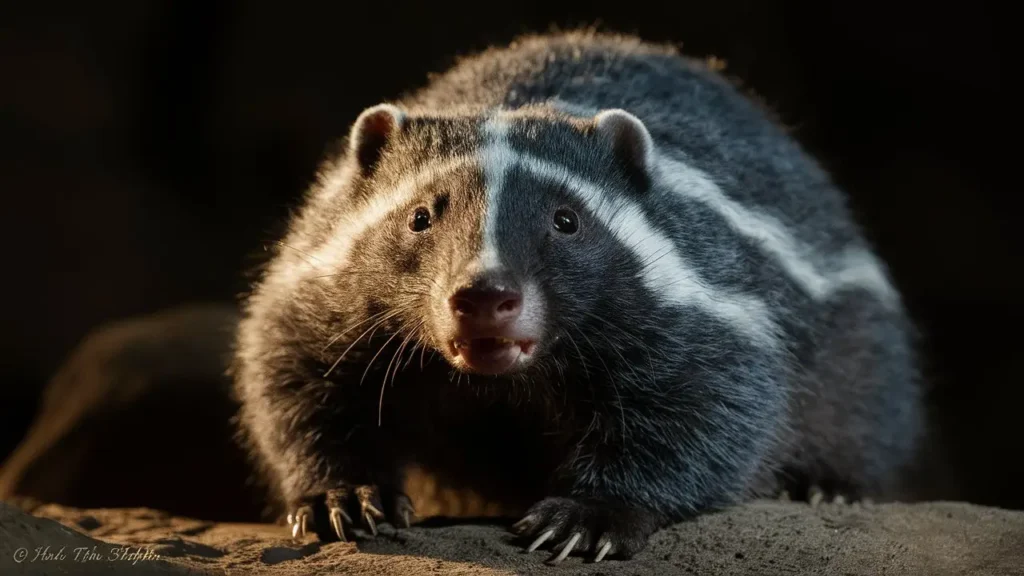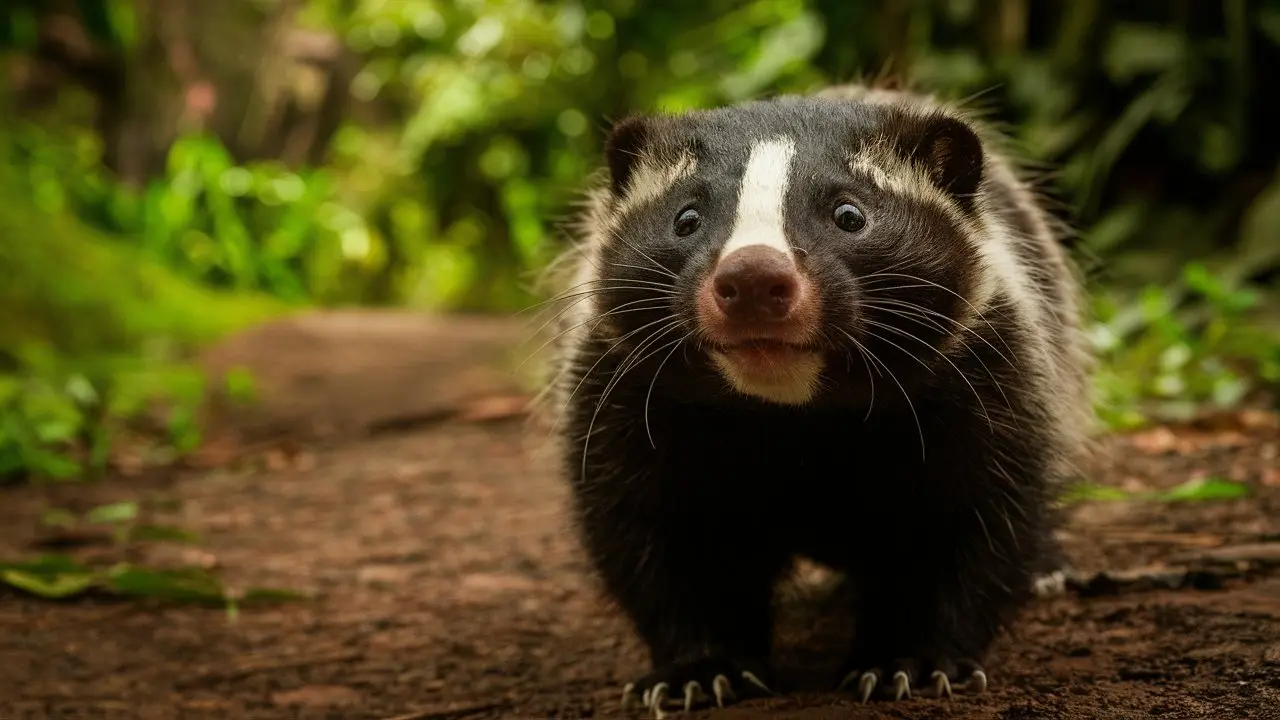Palawan Stink Badger: Behavior, Diet & Fun Facts
Have you ever heard of the Palawan stink badger? Native to the Philippines, this elusive creature is not your ordinary mammal. Known for its potent defense mechanism and solitary lifestyle, the Palawan stink badger is an animal shrouded in mystery. In this article, we’ll explore its unique traits, behaviors, and ecological importance while debunking common misconceptions about this fascinating species.
Introduction to the Palawan Stink Badger
The Palawan stink badger (Mydaus marchei) is a small, nocturnal mammal native to the island of Palawan in the Philippines. While its name suggests a relation to badgers, it is more closely related to skunks, as both belong to the Mephitidae family. This unique animal plays a crucial role in its ecosystem, balancing pest populations and aiding in forest regeneration.
Native Habitat and Appearance
The Palawan stink badger thrives in a variety of habitats, ranging from forests to grasslands, and even in mountainous regions of Palawan.
Key Physical Features
- Size: Measures between 12.5 and 18 inches in length and weighs 2.5–6.5 pounds.
- Coloration: Mostly black or dark brown with a prominent white stripe running from head to tail.
- Coat: Features short, dense fur adapted to its environment.
- Snout: Long and pointed, ideal for digging and foraging.
- Tail: Short, used for balance and communication.
Their bear-like gait and stout frame, combined with these physical traits, make them well-suited to their habitat.

SolitaryBehavior and Daily Life
Nocturnal Habits
Palawan stink badgers are nocturnal, meaning they are most active at night.
- Foraging: They use their excellent sense of smell and strong claws to locate food under the cover of darkness.
- Resting: During the day, they retreat to burrows or dense vegetation for safety.
- Territorial Marking: They use scent glands to establish territory and communicate with other stink badgers.
Burrowing Behavior
These animals are expert diggers, creating burrows that serve as both shelter and protection from predators.
- Construction: They use their strong claws to dig into forest floors, creating cozy nests lined with leaves and grass.
- Maintenance: Regular cleaning and repairs ensure their burrows remain functional.
Diet and Foraging
Diet Composition
The Palawan stink badger is an omnivore, with a diet that adapts to seasonal availability.
| Food Type | Examples |
|---|---|
| Insects | Beetles, larvae, worms |
| Fruits | Bananas, berries |
| Small Animals | Frogs, lizards |
| Plants | Leaves, roots |
Foraging Tactics
- They use their pointed snout to dig through soil and uncover prey.
- Their nocturnal foraging keeps them safe from predators.
- Seasonal changes in diet ensure nutritional variety.
For instance, they consume more fruits in the summer and insects in the spring when these resources are most abundant.
Defense Mechanisms
The Palawan stink badger has a unique and effective defense strategy: its powerful chemical spray.
Chemical Defense
- Source: Glands located at the base of the tail.
- Function: Releases a foul-smelling liquid to deter predators.
- Range: Can spray accurately up to a few feet away.
This defense is similar to that of skunks, making them formidable despite their small size.
Additional Strategies
- Camouflage: Their dark fur blends into nighttime surroundings.
- Vocal Warnings: Hisses and growls signal potential threats.
- Burrowing: Quick digging allows them to evade predators effectively.
Social Structure and Reproduction
The Palawan stink badger leads a solitary life, coming together only for mating.
Solitary Lifestyle
- They establish territories using scent marking.
- Encounters with others are rare and often involve aggression, except during mating season.
Reproductive Habits
- Mating occurs annually.
- Females give birth to 2–3 kits, which stay with their mother for a few months.
- Young stink badgers learn survival skills, including foraging and using their defensive spray, before venturing out on their own.
Role in the Ecosystem
The Palawan stink badger plays an essential role in maintaining ecological balance.
Key Contributions
- Pest Control: By consuming insects, they help regulate pest populations.
- Soil Aeration: Their digging activities improve soil health, promoting plant growth.
- Seed Dispersal: Eating fruits aids in the natural regeneration of forests.
Understanding their ecological importance highlights the need for their conservation.
Conservation Challenges
Despite their importance, the Palawan stink badger faces several threats.
Human-Driven Threats
- Deforestation: Logging and agricultural expansion destroy their habitats.
- Urbanization: Encroachment on natural areas reduces their living space.
- Hunting: Although not a common target, they can fall victim to local trapping practices.
Conservation Efforts
- Habitat preservation through protected areas.
- Educational campaigns to raise awareness of their ecological role.
- Research initiatives to better understand population trends and threats.
Fun Facts About the Palawan Stink Badger
- Not a True Badger: Despite its name, it is more closely related to skunks than badgers.
- Local Folklore: Often featured in Filipino legends as a symbol of resilience.
- Unique Gait: Its bear-like walk adds to its charm and distinctiveness.
- Spray Efficiency: Its defense mechanism is so potent that predators rarely risk a second encounter.
FAQs
What Do Palawan Stink Badgers Eat?
They primarily eat insects, fruits, and small animals, making them omnivorous.
Are Palawan Stink Badgers Endangered?
While not officially endangered, habitat loss and deforestation pose significant threats to their survival.
How Do Palawan Stink Badgers Defend Themselves?
They emit a foul-smelling spray from glands near their tail, which deters predators effectively.
Conclusion
The Palawan stink badger is a remarkable creature, embodying resilience and ecological significance. From its solitary nocturnal habits to its vital role in pest control and forest regeneration, this unique mammal deserves our attention and protection. By understanding and conserving their natural habitat, we can ensure these fascinating animals continue to thrive in the wild.

